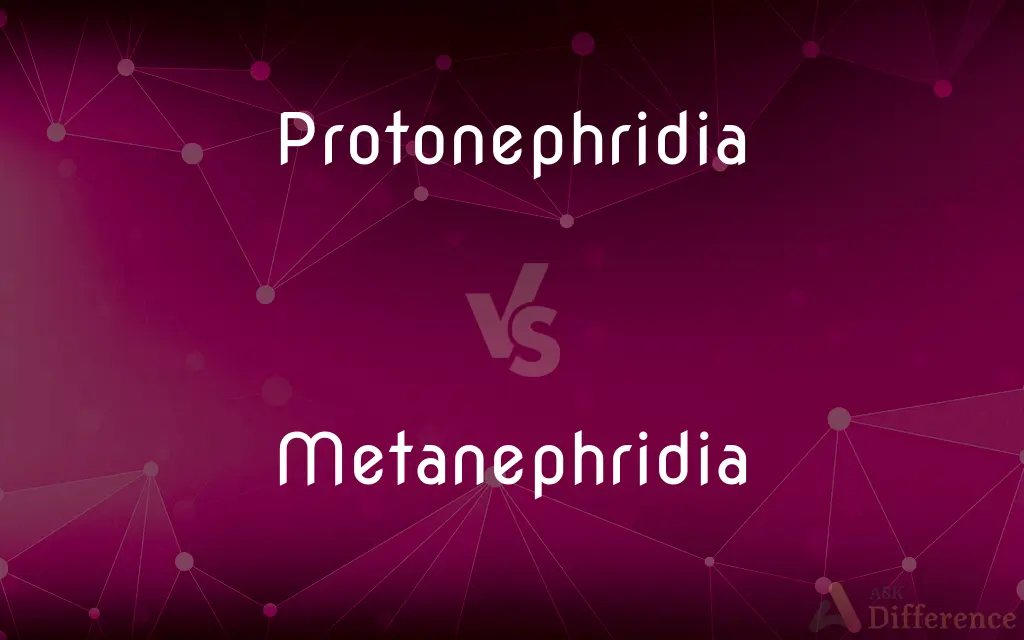Protonephridia vs. Metanephridia — What's the Difference?
By Tayyaba Rehman & Fiza Rafique — Published on February 8, 2024
Protonephridia are primitive, blind-end tubular structures for osmoregulation in simple organisms, while metanephridia are more advanced, with an open end, serving excretory functions in more complex organisms.

Difference Between Protonephridia and Metanephridia
Table of Contents
ADVERTISEMENT
Key Differences
Protonephridia, present in organisms like flatworms, consist of a network of dead-end tubules lacking an internal opening. In contrast, Metanephridia, found in annelids and mollusks, feature tubules with both internal and external openings, enabling a more complex and efficient excretory process. Both systems, however, are integral to the osmoregulation and excretion in their respective organisms.
The functioning of Protonephridia involves the flame cells or solenocytes that actively beat to draw in fluids. Metanephridia, on the other hand, rely on ciliated funnels called nephrostomes to filter body fluid. This fundamental structural and functional difference underlines the evolutionary complexity from Protonephridia to Metanephridia.
Protonephridia primarily play a role in osmoregulation, maintaining the organism's fluid balance, while Metanephridia take a step further by also removing metabolic wastes from the body. Despite their differences, both systems are crucial for the survival of their host organisms by maintaining internal homeostasis.
In the evolutionary context, Protonephridia represent a more primitive stage, suitable for the simple body plans of flatworms and other similar phyla. Metanephridia signify an evolutionary advancement, providing a more sophisticated excretory mechanism suited to the complex bodies of annelids and mollusks.
While Protonephridia operate in a closed system without a direct connection to the organism's exterior, Metanephridia connect to the exterior, allowing direct secretion of wastes. This comparison not only highlights the structural distinctions but also the evolutionary adaptation of excretory systems to meet the varying needs of different organisms.
ADVERTISEMENT
Comparison Chart
Structure
Blind-end tubules
Tubules with both internal and external openings
Primary Function
Osmoregulation
Osmoregulation and waste excretion
Organism Complexity
Found in simpler organisms like flatworms
Found in more complex organisms like annelids
Evolutionary Stage
Primitive
Advanced
Connection to Exterior
No direct connection
Direct connection for waste secretion
Compare with Definitions
Protonephridia
Comprised of a network of tubules ending in flame cells.
The flame cells in protonephridia ensure efficient filtration.
Metanephridia
Consist of tubules with internal and external openings.
The tubular structure of metanephridia facilitates effective waste processing.
Protonephridia
Function primarily in osmoregulation.
Protonephridia play a crucial role in the water balance of simple invertebrates.
Metanephridia
Feature nephrostomes for filtering body fluid.
Nephrostomes in metanephridia contribute to the meticulous filtration process.
Protonephridia
Lack an internal opening, forming a closed system.
The closed structure of protonephridia suits the organism's simple body plan.
Metanephridia
Advanced excretory system found in annelids.
Metanephridia efficiently remove waste from earthworms.
Protonephridia
Characteristic of simpler, acoelomate organisms.
In acoelomates, protonephridia are key to excretory processes.
Metanephridia
Serve in both osmoregulation and waste removal.
Metanephridia ensure the balance of fluids and the elimination of toxins.
Protonephridia
Primitive excretory system in flatworms.
Protonephridia maintain the osmotic balance in flatworms.
Metanephridia
Indicative of a more complex organism structure.
Metanephridia's presence reflects the evolutionary complexity of an organism.
Protonephridia
Plural of protonephridium
Metanephridia
Plural of metanephridium
Common Curiosities
How do Protonephridia function?
Protonephridia function through flame cells or solenocytes that filter and regulate body fluids.
What are Metanephridia?
Metanephridia are advanced excretory structures in more complex organisms, serving both osmoregulation and waste excretion.
Are Protonephridia evolutionary precursors to Metanephridia?
Yes, Protonephridia are considered more primitive, with Metanephridia representing an evolutionary advancement.
Where are Protonephridia found?
Protonephridia are found in phyla like Platyhelminthes (flatworms).
Do Metanephridia have a direct connection to the organism's exterior?
Yes, Metanephridia have an open system, allowing direct waste expulsion.
What are Protonephridia?
Protonephridia are primitive excretory structures in simple invertebrates, primarily for osmoregulation.
Where are Metanephridia found?
Metanephridia are found in annelids and some mollusks.
How do Metanephridia function?
Metanephridia use ciliated funnels called nephrostomes for filtration and waste removal.
Can Protonephridia remove metabolic waste?
Primarily, Protonephridia are involved in osmoregulation, not waste removal.
Do Protonephridia directly connect to the organism's exterior?
No, Protonephridia operate in a closed system without direct exterior connection.
Can Metanephridia regulate body fluid concentration?
Yes, Metanephridia contribute to osmoregulation in addition to waste removal.
Do Metanephridia reflect a more complex organism structure?
Yes, the presence of Metanephridia is indicative of a more complex, coelomate organism structure.
Are Protonephridia found in humans?
No, humans do not have Protonephridia.
Are Metanephridia found in humans?
No, humans have a different excretory system, not Metanephridia.
Do Protonephridia indicate a simpler organism structure?
Yes, Protonephridia are associated with simpler, often acoelomate organisms.
Share Your Discovery

Previous Comparison
Primary Key in Oracle vs. Unique Key in Oracle
Next Comparison
Magnetic Disk vs. Optical DiskAuthor Spotlight
Written by
Tayyaba RehmanTayyaba Rehman is a distinguished writer, currently serving as a primary contributor to askdifference.com. As a researcher in semantics and etymology, Tayyaba's passion for the complexity of languages and their distinctions has found a perfect home on the platform. Tayyaba delves into the intricacies of language, distinguishing between commonly confused words and phrases, thereby providing clarity for readers worldwide.
Co-written by
Fiza RafiqueFiza Rafique is a skilled content writer at AskDifference.com, where she meticulously refines and enhances written pieces. Drawing from her vast editorial expertise, Fiza ensures clarity, accuracy, and precision in every article. Passionate about language, she continually seeks to elevate the quality of content for readers worldwide.
















































